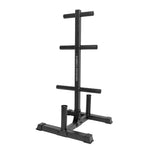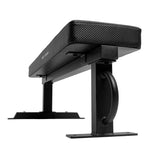Choose the Best Weight Plates For Your Home Gym
So, you've finally carved out the perfect workout space in your home. But now, when it comes to selecting the weight plates, you're faced with a dizzying array of options. The wrong choice could mean subpar workouts, wasted money, and endless frustration.
This guide is designed to remove the guesswork and confusion from the equation, empowering you to make confident weight plate buying decisions.
Choose the Right Plates at MACH Speed
There are four main factors to consider when choosing the perfect weight plates to meet your training needs:

Material
Accuracy
Compatibility
Handling
Material
The weight plate’s material determines its durability, aesthetics, maintenance requirements, and noise level. Let’s consider the various weight plate construction materials:
Powder-Coated Iron
Powder-coated Iron plates are known for their durability, longevity, and classic aesthetic. They can withstand a lot of wear and tear, making them an excellent long-term investment for home gyms.
These plates have the distinctive sound many associate with lifting weights, which can be good or bad depending on your preference. If you like hearing a satisfying clank as you load and unload your plates onto the bar, iron plates are the only way to go.
Powder-coated iron plates are often the most cost-effective purchasing option, and like our own powder-coated iron plates, these offer great long-term rust protection.
|
Powder-coated Iron plates may be an ideal choice if you: |
Rubber or Urethane Coating
Rubber and urethane-coated plates have a concrete or metal core with a rubber or urethane coating. The coating reduces noise compared to iron plates and is gentler on floors when set down with force.
Rubber-coated plates offer good durability and can withstand regular use in home gym environments. However, the rubber coating may degrade over time, especially with heavy usage, leading to chips, cracks, or peeling. Urethane is a type of thermosetting polymer known for its exceptional durability and resistance to abrasion.
While the rubber/urethane is completely rust-resistant, the metal underneath is typically untreated and rusts when moisture is trapped underneath. This is not an issue as long as the coating remains intact.
Rubber coated dumbbells have a strong odor and they take weeks to fully off-gas. Urethane coated dumbbells are more durable than rubber and do not come with the smell. However, they are much more expensive.
|
Rubber or Urethane-coated plates may be an ideal choice if you: |
Accuracy
Weight tolerance measures how accurate a plate’s stated weight is compared to how much it actually weighs.
The smaller a plate’s weight tolerance is, the more accurate its weight is. On the other hand, a larger weight tolerance indicates a less accurate weight. (For example, plates with a weight tolerance of 0.5% will be more accurate to their listed weight than plates with a 3% weight tolerance.)

Calibrated vs. Non-Calibrated Plates
Since calibrated plates are designed for competition, they have a much more strict weight tolerance than non-Olympic plates. Many calibrated plates have weight tolerance +/- 0.1% means a 45-pound plate may be up to 0.1% over or below 45 pounds (when looking at the exact numbers, this means a 45-pound weight can vary in actual weight from 44.955 pounds to 45.045 pounds.)
Most plates on the market are Non-Calibrated and these will have less strict weight tolerance of +/- 2% or more. Although non-Calibrated plates are less accurate, they can still acceptable for general fitness and non-competitive training. Just make sure you know the tolerance before you buy because consumers report cheap 45 plates that weigh anywhere from 41 to 49 pounds.
Competitive lifters need to pay more attention to weight tolerance. They need to lift an accurate amount of weight in order to measure their performance accurately.
For the vast majority of lifters that simply want to make weightlifting part of your overall fitness routine, you can get by with using non-calibrated plates as long as they are backed up with reasonable tolerance guarantees. You’ll still be lifting weight and doing work that will help you grow strong and stay fit.
Our Olympic Weight Plates set the standard with 2% tolerance guarantees for all of our weight plates. These guarantees are backed up with free replacements for any plates even an ounce out of tolerance. They’re an excellent choice for lifters who need plates with a tight weight tolerance but don't want to break the bank for Calibrated Plates.
Compatibility
Imagine the frustration of ordering weight plates and having them shipped to your door only to unpack them and find you can’t use them because they’re the wrong size.
By understanding how plates are measured and which plate sizes are compatible with different types of bars, you can make sure you choose weights that are compatible with your bar.
How Are Weight Plates Measured?
Weight plates are measured by the diameter of the hole in the center. There are two main plate sizes: 2” plates (Olympic plates) and 1” plates (non-Olympic plates).

What Size Plates Do I Need If I Have An Olympic Bar?
If you have an Olympic bar, you need to buy Olympic plates. Olympic bars have a 2-inch diameter, so they need plates that will fit that dimension. Since 2 inches is the standard size for all Olympic bars and weights, you can buy any brand of Olympic bars or plates and know they will be compatible.
This compatibility factor is a big reason why Olympic bars and plates are popular for home workout enthusiasts. It makes buying plates and bars easier because you don’t have to worry about choosing the wrong size.
What Size Plates Do I Need If I Have A 1” Bar?
Non-Olympic bars are smaller in length and diameter, so you'll need smaller plates if your bar isn't an Olympic bar. Non-Olympic bars have a 1” diameter, so you’ll need to look for plates with a 1” diameter to fit them.

Handling
After determining the size and weight tolerance of your plates, you need to think about how you want the plates to feel when handling them. You want your plates to be comfortable to pick up, hold, and move around. Plates that are easiest to handle have two key features:
- A raised edge
- Handles or grip holes
A weight plate that has raised inserts is raised around the center of the plate, where the hole allows it to slide onto the bar. When a plate is lying on the ground, the insert raises the plate so there's a gap between the plate and the floor. This lets you easily slip your hand under the plate to pick it up.
Handles/Grip HolesSome plates have handles that allow you to wrap your hand through the weight to pick it up and carry it. Other plates, like ours, have grips along the outside. Grips are the raised outer edge of a plate (similar to raised inserts, just placed around the outer circle of the plate). They're slightly different from handles but still allow you to get a good grip on the plate to carry it without dropping it.
The graphic below demonstrates how raised edges and handles/grip holes help you easily lift and carry the plates.

Ultimately, whether you choose plates with raised edges or handles/grip holes is up to you and what you prefer. Some people like the traditional look of plates with raised edges, while others find it easier to handle plates with grip holes. It all depends on what you find easiest to use and which type of look you prefer.
| Our Olympic plates have raised edges that lend themselves to a classic style while also making them easy to grip from the sides.
FAQs
Q: Why Am I Seeing Plate Sizes Slightly Larger Than 1 and 2 inches?
A: When looking at plate and bar dimensions, the measurements won’t be listed as exactly 1 or 2 inches. Bars measure slightly less than 1” or 2” while plate diameters need to be slightly bigger than 1 or 2 inches. This size discrepancy allows the plate to fit on the bar properly.
For example, our Olympic plates technically measure 51.5mm or 2.02”. The extra .5mm allows the plates to have enough room to fit perfectly around our 50mm Olympic bars.)
So don’t stress if you see plates that are listed at odd diameters like this. They’re supposed to be that way.
Q: If I have a 1” bar, can I just use a 2” Olympic plate on it anyway since it will fit?
A: Although it can be tempting if you have 2-inch plates lying around already, you should never attempt to lift a bar with plates that are too big. The plates can slide around, making the bar difficult to handle. You'll be asking for an injury, and even if you don't get hurt, you'll have a very clumsy and uncomfortable lifting experience. (Plus, the extra sliding can damage your bar and your plates.)
Final Thoughts
Weight plates are the workhorses of your home gym. They need to be functional, durable and easy to handle. You also want your plates to look good. Barbell Standard plates cover all your bases - and they’re exceptionally well priced!
To help you get started, here are our top picks for Olympic and non-Olympic plates:
Our Recommendations: Olympic 2" Plates
- Powder-Coated Olympic Plates: Barbell Standard Olympic Weight Plates
- Rubber-Coated Olympic Plates: REP Rubber-Coated Olympic Plates
- Urethane-Coated Olympic Plates: American Barbell Urethane-Coated Olympic Plates
Our Recommendations: Non-Olympic 1" Plates
- Cast-Iron Non-Olympic Plates: Fitness Factor Body-Solid Cast Iron Standard Plates
- Rubber-Coated Non-Olympic Plates: SPART Color Coded 1-Inch Weight Plates
Why Choose Barbell Standard Weight Plates?
Our plates are manufactured with category leading precision for accurate weight tolerance, reliable bar compatibility, and a balanced load for every rep. The iconic design comes with a robust finish that is durable enough to withstand the rigorous demands of your workouts.



